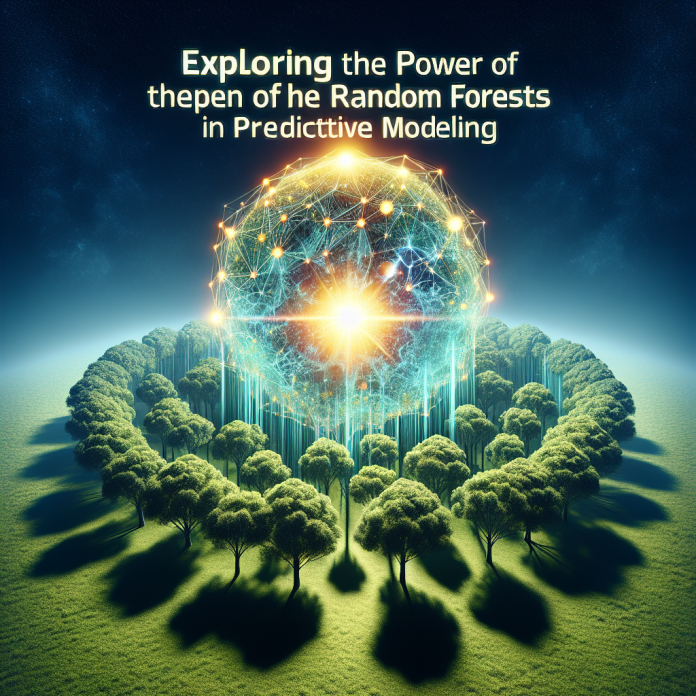Introduction
Imagine you are lost in a dense forest, surrounded by countless trees with no clear path to follow. Sounds intimidating, right? Well, in the world of data science, a similar concept exists – Random Forests. But don’t worry, navigating through this complex algorithm doesn’t have to be as daunting as finding your way out of a real forest.
What are Random Forests?
To put it simply, Random Forest is a versatile machine learning algorithm that is used for both classification and regression tasks. It belongs to the ensemble learning category, meaning it combines multiple decision trees to make more accurate predictions.
Picture a forest with multiple trees, each representing a decision tree. These trees work together, voting on the outcome of a certain prediction. The “majority rules” principle is applied here – the most popular prediction across all trees is chosen as the final result.
Random Forests are powerful and widely used in various fields such as finance, healthcare, and marketing when dealing with large datasets. They are known for their robustness, scalability, and ability to handle high-dimensional data.
The Magic Behind Random Forests
Now, let’s demystify how Random Forests actually work. The “random” aspect in the name refers to two key elements:
1. Bootstrap Sampling: When building each tree in the forest, Random Forests randomly select a subset of data observations with replacement. This means some samples may be repeated while others are left out. This process diversifies the training data for each tree, reducing the risk of overfitting.
2. Feature Randomness: Random Forests also introduce randomness by selecting a random subset of features at each split when constructing the decision tree. This helps to prevent the model from relying too heavily on a single feature, leading to more robust and accurate predictions.
As the trees grow independently of each other, they collectively form a strong and reliable model. No one tree is the decision-maker; instead, they all contribute to the final output through a democratic voting process.
Real-life Example
To better understand how Random Forests work, let’s use a practical example. Imagine you are a farmer trying to predict the yield of your crops based on various factors like temperature, rainfall, soil type, and fertilizer usage. By collecting historical data on crop yields along with these features, you can train a Random Forest model to make predictions on future yields.
Each decision tree in the Random Forest focuses on a different subset of features and observations from your dataset. One tree might hone in on the impact of temperature on crop yield, while another tree looks at the relationship between soil type and crop productivity. By combining the insights from all trees, the Random Forest provides a more accurate and robust prediction of your crop yield.
Benefits of Random Forests
Random Forests offer a plethora of advantages that make them a popular choice among data scientists:
1. High Accuracy: Random Forests are known for their high accuracy in predicting outcomes, especially in complex datasets with multiple variables.
2. Robustness: Random Forests can handle noisy and missing data effectively, making them robust in real-world scenarios.
3. Feature Importance: By analyzing the importance of features in the model, Random Forests provide valuable insights into which factors have the most impact on the predictions.
4. Scalability: Random Forests can easily scale to large datasets with thousands of features, making them suitable for big data applications.
5. Interpretability: Despite being an ensemble model, Random Forests can still provide insights into how the decisions are made, thanks to feature importance analysis.
Challenges of Random Forests
While Random Forests have numerous benefits, they also come with their own set of challenges:
1. Computationally Expensive: Training a Random Forest model can be computationally intensive, especially with a large number of trees and features.
2. Overfitting: Despite its built-in mechanisms to prevent overfitting, Random Forests can still suffer from this issue if not properly tuned.
3. Interpretability: While Random Forests offer insights into feature importance, understanding the inner workings of each tree in the forest can be complex and challenging.
4. Data Imbalance: Random Forests may struggle with imbalanced datasets, where one class is significantly more prevalent than another, leading to biased predictions.
How to Use Random Forests Effectively
To harness the full potential of Random Forests, here are some tips for using them effectively:
1. Tune Hyperparameters: Experiment with hyperparameters like the number of trees, maximum depth of trees, and minimum samples per leaf to optimize the model’s performance.
2. Feature Engineering: Preprocess your data by performing feature engineering to extract relevant information and improve the model’s predictive power.
3. Cross-Validation: Use techniques like k-fold cross-validation to evaluate the model’s performance and ensure it generalizes well to unseen data.
4. Ensemble Learning: Combine Random Forests with other ensemble methods like Gradient Boosting to create more powerful models that leverage the strengths of each algorithm.
Conclusion
In the vast forest of machine learning algorithms, Random Forests stand out as a robust and versatile tool for making accurate predictions. By harnessing the power of multiple decision trees and leveraging randomness, Random Forests have become a go-to choice for data scientists across various industries.
So, the next time you find yourself lost in the wilderness of data analysis, remember the guiding light of Random Forests to help you navigate through the complexity and uncertainty. Just like a forest ecosystem thrives on diversity and collaboration, Random Forests bring together the collective wisdom of individual trees to deliver reliable and insightful predictions.

